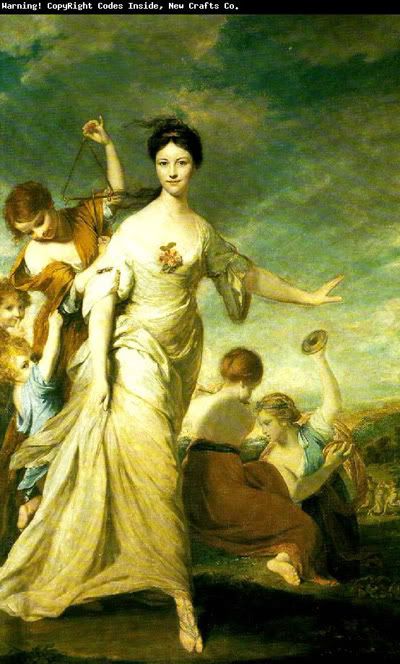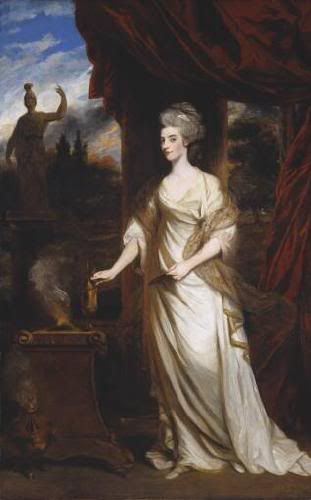Fashion in Reynolds and Gainsborough: Part 3
1:35 PM
In many of his portraits Reynolds took this referencing of classical deities a step further, portraying his sitter as a goddess or other classical being. His portrait Mrs. Hale as ‘Euphrosyne’ from 1766 casts the sitter as the Ancient Greek figure Euphrosyne, one of the Three Graces and the goddess of joy and good cheer. The Three Graces could often be found dancing together, an idea referenced by Reynolds by the background figures playing musical instruments. Once again almost all references to contemporary fashion are removed, the only remnant being the fitted nature of the top of the gown to the upper body and the wide scooped neckline. Mrs. Hale steps lightly forward in the painting, her foot elegantly outstretched in a dancelike pose. The figures immediately around her dance to the music they are creating, as well as the very small figures on the field in the background of the painting. The scene is set on rolling hills, with most of the background being the sky. All of this suggests Mrs. Hale delighting in a dance through nature, springing lightly over hills and fields and enjoying the wind in her hair, her happy commune with nature reflecting the Rousseauean ideals popular in the period. By casting Mrs. Hale as Euphrosyne, Reynolds suggests that she has all the qualities of this goddess- she spreads joy and good cheer everywhere she goes.

Other references to classical deities are more serious. Reynolds’ portrait Lady Talbot, painted in 1781, shows a much more academic bent. While Mrs. Hale is associated with a goddess of joy and happiness, Lady Talbot is associated with Athena, goddess of wisdom, learning, and the arts. She wears a simple Grecian dress, and has just poured an offering of oil to the statue of Athena in the background. Her dress and action suggests that she is a disciple of Athena, dedicated to knowledge and wisdom. Rather than showing herself to be a slave to the frivolities of fashion, Lady Talbot shows herself as an intelligent and learned woman who is more interested in cultivating her mind than her wardrobe, as seen by the simplicity of her draped garment, and associates with the great minds of the ancient world.



1 comments